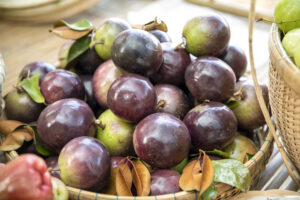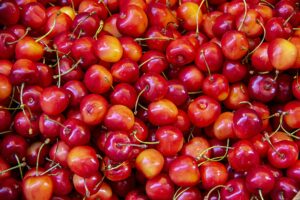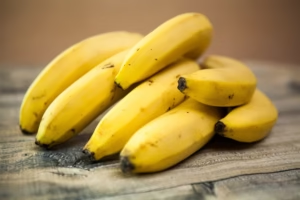How to Grow and Care for Nectarine Trees: A Complete Guide
Growing nectarines at home can be incredibly rewarding. With their sweet, juicy fruits and beautiful spring blossoms, nectarine trees make a wonderful addition to any garden, patio, or even indoor growing space. This comprehensive guide will walk you through everything you need to know about growing and caring for nectarine trees in different settings.
Understanding Nectarines
Nectarines (Prunus persica var. nucipersica) are essentially fuzzless peaches. They belong to the same species as peaches but have a recessive gene that gives them smooth skin. Like peaches, nectarines are stone fruits related to almonds, cherries, and plums.
Popular Nectarine Varieties for Home Growers
| Variety | Chill Hours | USDA Zones | Self-Fertile | Special Features |
|---|---|---|---|---|
| Fantasia | 400-500 | 5-9 | Yes | Large yellow fruit, good disease resistance |
| Arctic Sweet | 700-800 | 5-8 | Yes | White flesh, super sweet |
| Flavortop | 500-600 | 6-9 | Yes | Bright red skin, firm yellow flesh |
| Snow Queen | 400-500 | 5-9 | Partially | White flesh, low acid |
| Nectar Babe | 300-400 | 7-10 | Yes | Dwarf variety (6-8 ft), perfect for containers |
| Mericrest | 800-1000 | 4-8 | Yes | Cold hardy, disease resistant |
| Southern Belle | 250-350 | 7-9 | Yes | Low chill requirement, good for warm regions |
Choosing the Right Growing Location
Before you start growing nectarines, it’s important to consider your climate and growing conditions:
- USDA Hardiness Zones: Most nectarine varieties thrive in zones 5-9, though some specialty varieties exist for zones 4-10.
- Chill Hours: Nectarines need a certain number of hours below 45°F (7°C) during winter to produce fruit properly. Most varieties need 500-900 chill hours.
- Sun Exposure: Nectarines require full sun (6-8 hours minimum) to produce sweet fruit.
- Soil Drainage: Well-draining soil is essential to prevent root rot.
Growing Nectarines Outdoors

Site Preparation
- Choose a sunny location with protection from strong winds.
- Test your soil and aim for a slightly acidic to neutral pH (6.0-7.0).
- Improve drainage by adding organic matter if your soil is heavy clay.
- Provide adequate spacing – standard trees need 15-20 feet between them, while dwarf varieties need 10-12 feet.
Planting Bare Root Trees
According to the USDA’s Agricultural Research Service, late winter to early spring is the best time to plant bare root nectarine trees in most regions (source: USDA ARS).
- Soak the roots in water for 2-4 hours before planting.
- Dig a hole twice as wide as the root spread and just deep enough to accommodate the roots.
- Create a small mound in the center of the hole to support the root crown.
- Position the tree so the graft union is 2-3 inches above the soil line.
- Backfill with soil, tamping gently to remove air pockets.
- Water thoroughly after planting.
Growing from Seed (Advanced)
Growing nectarines from seed is possible but challenging:
- Extract seeds from fully ripe fruits.
- Clean thoroughly to remove all flesh.
- Stratify seeds by placing them in damp paper towels inside a plastic bag in the refrigerator for 2-3 months.
- Plant stratified seeds in small pots with well-draining soil mix.
- Transplant outdoors after all danger of frost has passed and the seedling is strong.
Remember that trees grown from seed:
- Won’t be identical to the parent tree
- Take 3-5 years to bear fruit
- May produce lower quality fruit than grafted varieties
Growing Nectarines in Containers
Container growing is perfect for small spaces or cooler climates where you need to move trees indoors for winter.
Choosing the Right Container
- Select a dwarf or genetic dwarf variety like Nectar Babe, Garden Delight, or Honeydrop.
- Use a large container at least 18-24 inches in diameter and depth.
- Ensure good drainage with multiple drainage holes.
Potting Soil and Planting
- Create a custom mix of 1/3 garden soil, 1/3 perlite or pumice, and 1/3 compost.
- Plant at the same depth as the tree was growing previously.
- Leave 2 inches at the top for watering.
Special Container Care Requirements
- Water more frequently than ground-planted trees.
- Fertilize regularly with a balanced organic fertilizer formulated for fruit trees.
- Monitor for pests more vigilantly as container trees can be more stressed.
- Protect from temperature extremes by moving containers to sheltered locations during extreme weather.
Essential Nectarine Tree Care
Watering Requirements
- Young trees need 5-10 gallons of water weekly in the growing season.
- Established trees need deep watering every 10-14 days during dry periods.
- Avoid overhead watering to prevent fungal diseases.
- Reduce watering in fall to help trees prepare for dormancy.
Fertilization Schedule
- First year: Apply a balanced fertilizer (10-10-10) in spring when new growth appears.
- Established trees: Apply nitrogen-rich fertilizer in early spring before bud break.
- Follow up with a second lighter application after fruit set.
- Stop fertilizing by mid-summer to allow the tree to harden off for winter.
The National Institute of Food and Agriculture recommends conducting a soil test before applying fertilizers to avoid over-application (source: NIFA).
Pruning for Health and Productivity
- Train young trees to an open center or vase shape for maximum sun exposure.
- Prune during dormancy (late winter) to minimize disease risk.
- Remove dead or diseased wood whenever noticed.
- Thin fruit to 6-8 inches apart when they reach marble size for larger, better quality fruit.
Pest and Disease Management
Common nectarine pests and diseases include:
- Peach leaf curl: Apply copper-based fungicide during dormancy.
- Brown rot: Remove and destroy affected fruit; apply approved fungicides.
- Peach tree borers: Monitor trunk for sawdust-like frass; use appropriate controls.
- Aphids: Spray with insecticidal soap or introduce beneficial insects.
The Environmental Protection Agency provides information on approved pesticides and integrated pest management strategies for home fruit growers (source: EPA).
Harvesting and Enjoying Your Nectarines
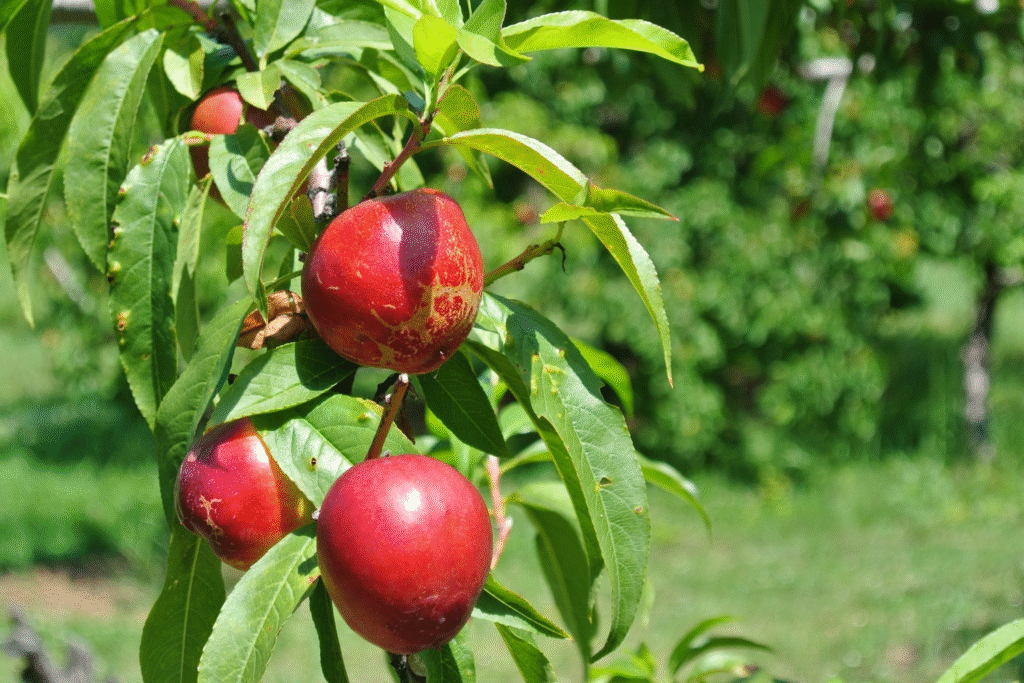
When to Harvest
- Color change: Background color changes from green to yellow or white.
- Slight give: Fruit yields slightly to gentle pressure.
- Aroma: Sweet fragrance develops when ripe.
- Taste test: The ultimate test is flavor!
Storing Your Harvest
- Short-term storage: Keep at room temperature for 2-3 days.
- Medium-term storage: Refrigerate for up to 2 weeks.
- Long-term storage: Freeze sliced nectarines, can them, or dehydrate for year-round enjoyment.
Using Your Nectarines
- Fresh eating: Nothing beats a perfectly ripe nectarine!
- Baking: Nectarine pies, cobblers, and crisps showcase their sweet flavor.
- Preserves: Make jams, jellies, and chutneys.
- Savory dishes: Add to salads or pair with grilled meats.
Overcoming Common Challenges
No Fruit Production
- Insufficient chill hours: Choose varieties suited to your climate.
- Improper pollination: Plant self-fertile varieties or multiple trees.
- Young tree: Most trees need 2-4 years before fruiting.
- Over-fertilization: Too much nitrogen promotes vegetative growth at the expense of fruit.
Leaf Problems
- Yellowing leaves: May indicate nutrient deficiencies or overwatering.
- Curled leaves: Often a sign of peach leaf curl fungus.
- Spotted leaves: Could be bacterial spot or other fungal issues.
The USDA’s Cooperative Extension System offers free diagnostic services and advice for home gardeners facing fruit tree problems (source: USDA Extension).
Regional Considerations for US Growers
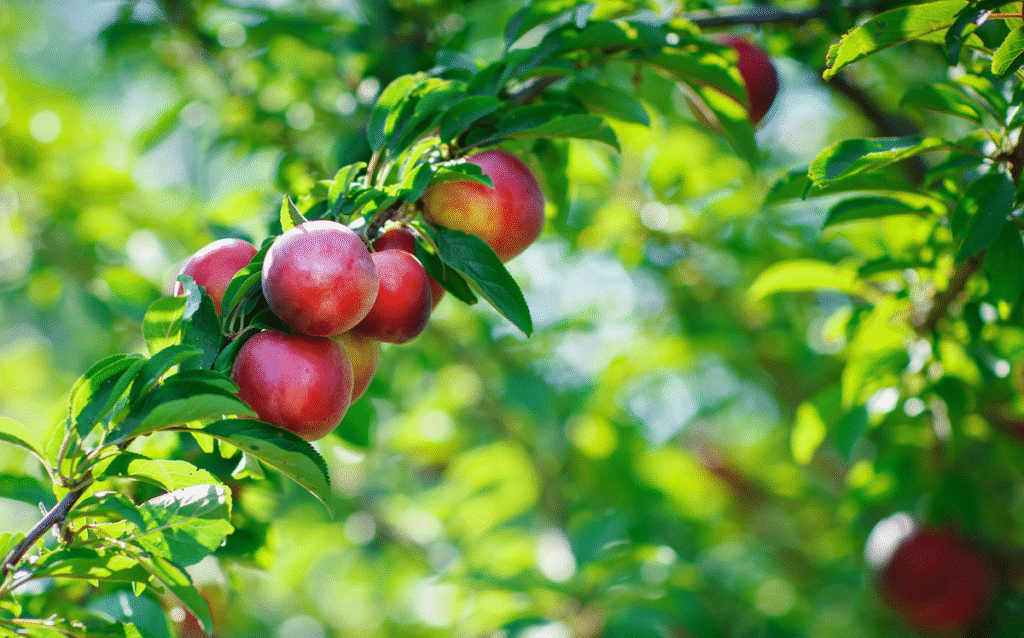
Western US
The warm, dry climate is ideal for nectarines but irrigation is essential. Choose low-chill varieties for coastal Southern California and standard varieties for inland areas.
Southern US
Select very low-chill varieties (under 400 hours). Watch for humidity-related fungal issues and implement rigorous disease management practices.
Midwest and Northeast
Choose cold-hardy varieties with higher chill requirements. Provide winter protection for young trees and be vigilant about spring frost protection for blossoms.
Conclusion
Growing nectarines at home requires some effort, but the rewards are substantial. By selecting appropriate varieties for your region, providing proper care, and addressing problems promptly, you can enjoy these delicious fruits for many years. Whether you’re growing in a spacious backyard or on a sunny balcony, there’s a nectarine variety that can thrive in your care.
Remember that patience is key – while some dwarf varieties may produce fruit in just 2-3 years, standard trees often take 3-5 years to begin bearing. The wait is well worth it when you bite into that first sun-warmed, tree-ripened nectarine from your very own tree!

